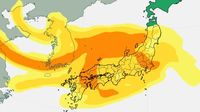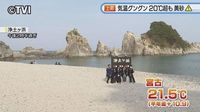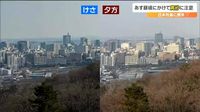On March 25, 2025, several regions in Japan experienced a significant rise in temperatures while an influx of yellow dust, or "kosa," raised concerns regarding air quality and visibility.
In Ichinoseki, the highest temperature recorded soared to 22.1 degrees Celsius, the first time this year that the temperature had reached such a high mark. Other cities also noted warmer weather, with Kurosawaishi registering 21.6 degrees Celsius and Esashi, Oshu City, hitting 21.2 degrees Celsius. The warm spell was attributed to a surge of warm air from the south.
However, with the rising temperatures came the warning of worsening air quality due to yellow dust. As early as the morning of March 25, the Osaka District Meteorological Observatory reported charges of yellow dust swirling over the area. Concerns escalated throughout the day as it became evident that the dust would travel across large portions of Japan, reaching regions as far north as Tohoku.
According to the Japan Meteorological Agency, visibility in some areas could drop below five kilometers, prompting warnings against outdoor activities such as hanging laundry out to dry. The forecast for March 26 suggested that strong winds, particularly from the west, would exacerbate the situation.
Residents in Sendai also basked in warmer weather, with the city's center marking a high of 22.4 degrees Celsius—the warmest recorded so far this year. Locals expressed surprise at the warmth, some dressed in light clothing, feeling the unexpected heat after assuming they would encounter the cold typical of northern Japan in March.
A survey conducted by the Weather News application revealed that over 6000 users reported conditions such as hazy skies and dust accumulation on vehicles and balconies. More than 60% of respondents confirmed visibility issues, contributing further to concerns about public health, especially for individuals suffering from allergies or respiratory conditions.
"People are taking preventive measures; I'm wearing a mask to stay safe from the dust," said a local resident, who preferred to remain anonymous. Many reported adjusting their daily routines as the yellow dust moved in, with some expecting to wash their cars more frequently due to expected accumulation.
The forecast from the Sendai Regional Meteorological Observatory indicated that by the afternoon of March 25, yellow dust had not yet been observed, but if it did show up, it would be the first sighting in nearly 11 months.
Authorities recommended wearing masks and staying indoors as much as possible, especially on March 26 when conditions may worsen. Weather predictions indicated that airborne dust might originate from desert regions in inland China, transported across Japan by westerly winds.
Incidents tied to poor visibility were reported prior to the expected presence of the yellow dust. On March 25, a major vehicle collision occurred in Hokkaido, when a rental car struck a truck, resulting in one man suffering cardiac arrest and later succumbing to his injuries. This situation underscores the dangers posed by diminished visibility on the roads.
As the warm weather continues into the week, experts warn of potential rises in pollen levels, which could exacerbate allergies for many individuals alongside the already troublesome impact of yellow dust.
It's apparent that while many are enjoying the warmer weather, the accompanying yellow dust will bring its own challenges, including significant air quality issues that might necessitate changes in how residents manage their daily activities outdoors.
Officials continue to issue advisories throughout the affected regions, urging residents to remain vigilant about the air quality and follow any guidance related to outdoor activities until conditions improve.
The situation with yellow dust is not isolated. The Health Ministry has noted that dust accumulation can lead to serious respiratory issues, especially among vulnerable populations, including children and the elderly. It's advised that anyone with respiratory or allergy issues consult health professionals to mitigate risks associated with the dust.
As we inch closer to March 26, all eyes will be on the sky as residents prepare for what could be a challenging day due to the anticipated dust fallout. Continuous updates will come from meteorological offices as they monitor the progress of this exceptional weather pattern impacting Japan.









